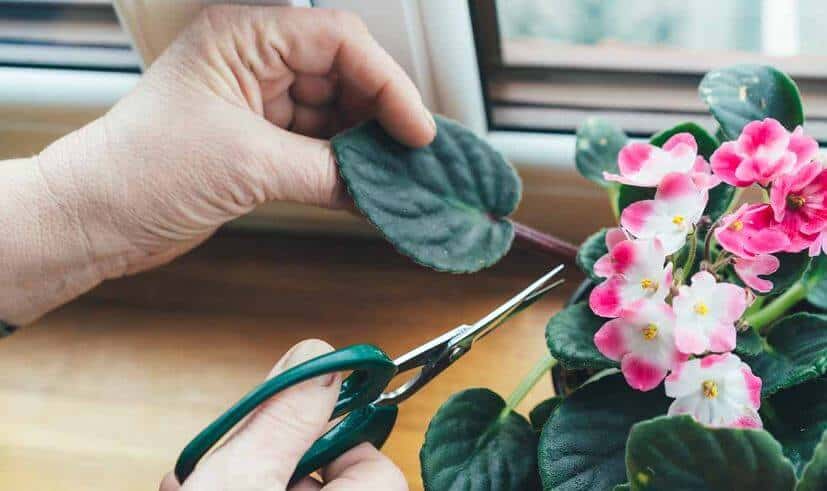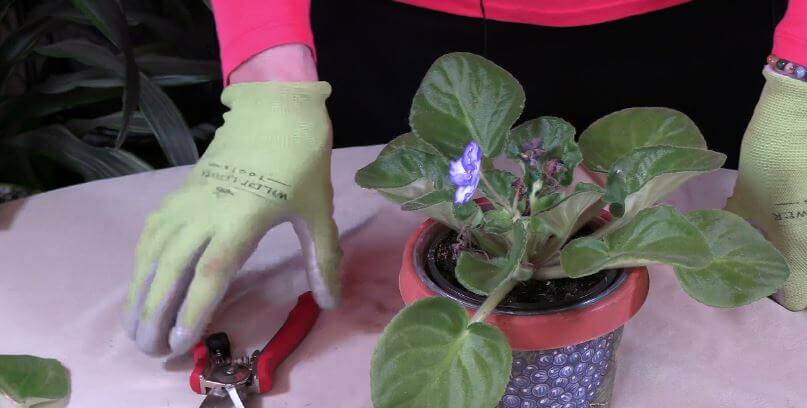Last Updated on October 3, 2023 by a Friendly Gardener
African violets are beloved houseplants that add a touch of vibrant color to homes and offices. The Saintpaulia is appreciated for its colorful blooms and unique fuzzy foliage. Pruning is essential to this plant’s care routine to maintain an African violet’s appearance and health. One of the fortunate aspects of pruning African violets is that it does not require special tools such as gardening shears, as you can prune ideally using your hands.
About Pruning African Violets

Slightly furry foliage paired with colorful blooms in a petite plant explains why the African violet is so popular. You can find a spot for one anywhere as they don’t require much space, just some bright indirect lighting. Pruning is an easy chore that doesn’t require any particular skill.
When referring to pruning, most imagine a slightly overgrown hedge and a large pair of gardening shears. Yet pruning refers as much to sizeable outdoor garden vegetation as to tiny houseplants. Fortunately, with the African Violet, a good pair of fingernails or smallish-tipped gardening scissors are sufficient to complete the job.
The reason for pruning African violets is to remove spent flowers, damaged foliage, or dead leaves from your plant. Keeping your plant clean will encourage new growth as the plant will have more opportunities to access air and light. An added benefit to cultivating an African violet is that you can prune it whenever you like or whenever your plant needs it all year, which is only valid for some houseplants.
How to Prune African Violets

Remove several bottom leaves from the plant monthly to contribute to your African violet’s overall health. Select at least three. As African violets continue to produce foliage regularly, removing several leaves monthly will help maintain a balanced appearance and allow new leaves to grow.
Removing spent flowers once they pass will also contribute to the growth of new blooms. An important reason to remove spent flowers and foliage is that this frees up energy the plant can dedicate to producing new growth. The plant will no longer send necessary resources to dying plant parts that cannot return to a healthier state. Pruning also allows for better airflow to the plants.
Use your thumb and forefinger to pinch off spent flowers or damaged and dying leaves to prune your African violet. You can also employ a pair of small, sterilized gardening scissors. Remove the plant parts to be trimmed as close to the base as possible, but take care not to cut into the plant’s principal stem.
Knowing which leaves should be trimmed first is as vital as pruning. Trimming leaves will encourage blooming, as African violet plants with too many leaves may not produce many flowers. Plants only have access to limited quantities of sunlight, nutrients, and water at any time, and houseplants must decide where to send that energy. Leaves are always a better choice as they have the vital work of photosynthesis to perform, whereas flowers do not produce resources but rather consume them for seed production purposes. Your plant will spontaneously send more resources to foliage to survive. Better yet, African violets can use clusters of their foliage to produce new plants, so the plant is not obliged to produce flowers to ensure propagation and continue its gene pool.
Does My African Violet Have Too Many Leaves?

Knowing if your African Violet plant has too many leaves is relatively easy. If your plant has five rows of leaves, it could do with some pruning. Only the core rings of the first three to five rows will produce flower buds. Further rows of foliage will only consume the plant’s energy without contributing to flowering. Know that you can prune rows to the fourth core ring to prioritize blooming.
When identifying rows, begin your counting from the crown or center leaves. Each row should contain three leaves. When you want to encourage blooming, keep your plant’s leaves to fifteen at the most.
Also, be aware of the African violet’s tendency to reproduce asexually. The plant will often develop suckers that appear as clusters of leaves emerging from the soil bed around the parent plant’s edges. These will push upward as new plant crowns, but when left to do so, they will drain nutrients and energy from the parent plant. These should be removed as soon as you notice them. Look for them under more significant, older leaves.
Basal Leaf Pruning and Propagation

Occasionally, during pruning, home gardeners may trim off some healthy foliage, whether by accident or purposefully. The African violet should be considered a forgiving plant, so don’t worry if you remove some healthy leaves, especially if it improves your plant’s appearance. A bonus to your pruning is that these leaves can be used to propagate new African Violet plants.
Prepare a small flowerpot with a moistened, well-draining African violet soil mixture. Take a pruned leaf and insert its petiole into the potting soil. In several months, roots should form, and you’ll have a new plant. These trimmed leaves can also be rooted by placing them in water. You will need to use toothpicks or similar to keep the leaf above the water. Again, you will need a few months before your new plant develops roots.
In Conclusion

It’s a good practice to prune African violet leaves monthly by pinching them off at the base of the petioles. You can trim with a small pair of sharp scissors or a gardening knife. Always begin pruning from the bottom upward by trimming off the lowest and oldest leaves first.
Other reasons to prune include severe pest infestations, bacterial infections, or fungal diseases to prevent the spread. You may also wish to prune leaves that have naturally aged or suffered sun damage, environmental temperature shock, or dehydration.

